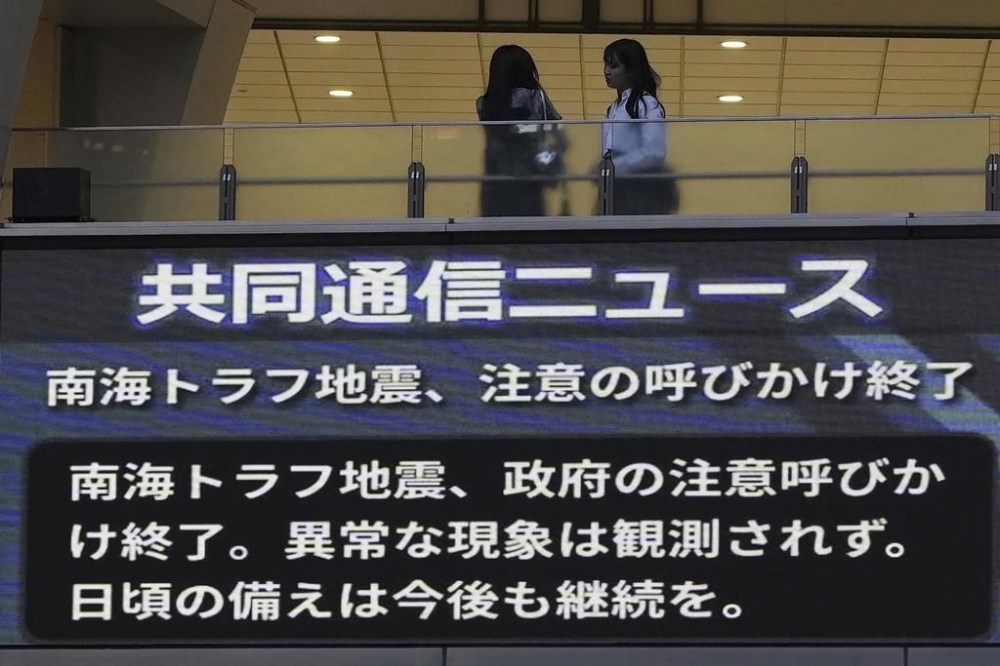Japan ends ‘megaquake’ special caution week after finding no immediate risk
Advertisement
Read this article for free:
or
Already have an account? Log in here »
To continue reading, please subscribe:
Monthly Digital Subscription
$0 for the first 4 weeks*
- Enjoy unlimited reading on winnipegfreepress.com
- Read the E-Edition, our digital replica newspaper
- Access News Break, our award-winning app
- Play interactive puzzles
*No charge for 4 weeks then price increases to the regular rate of $19.00 plus GST every four weeks. Offer available to new and qualified returning subscribers only. Cancel any time.
Monthly Digital Subscription
$4.75/week*
- Enjoy unlimited reading on winnipegfreepress.com
- Read the E-Edition, our digital replica newspaper
- Access News Break, our award-winning app
- Play interactive puzzles
*Billed as $19 plus GST every four weeks. Cancel any time.
To continue reading, please subscribe:
Add Free Press access to your Brandon Sun subscription for only an additional
$1 for the first 4 weeks*
*Your next subscription payment will increase by $1.00 and you will be charged $16.99 plus GST for four weeks. After four weeks, your payment will increase to $23.99 plus GST every four weeks.
Read unlimited articles for free today:
or
Already have an account? Log in here »
Hey there, time traveller!
This article was published 15/08/2024 (462 days ago), so information in it may no longer be current.
TOKYO (AP) — Japan’s government Thursday ended a weeklong information campaign urging caution and preparedness for a possible “megaquake” — an earthquake of magnitude 8 strength or higher — striking the Pacific coast. The announcement came after no abnormal seismic activity was detected during the past week.
Still, officials urged people not to let their guards down.
The Japan Meteorological Agency issued the country’s first-ever “megaquake advisory” on Aug. 8, hours after a magnitude 7.1 earthquake struck off southwestern Japan. That quake happened on the westernmost edge of a disaster-prone undersea trench called the Nankai Trough, and the meteorological agency said the risk of another big one hitting somewhere along the trough was higher than normal.

The government, in response, designated the past week as a period of “special caution” and preparedness in the region along the trough, calling on residents to be prepared to flee immediately.
A Cabinet Office disaster response official, Tsukasa Morikubo, announced the end of the caution period as of Thursday evening, noting that seismologists detected no abnormal seismic activity around the Nankai Trough in the past week.
The end of the special caution period does not mean there is no risk of a megaquake, said Morikubo, urging people to keep up their usual earthquake preparedness. “A next major one can hit anytime, anywhere,” Morikubo said.
The government last week called on more than 700 municipalities in 29 of the 47 Japanese prefectures to review their preparedness and evacuation plans in response to the Aug. 8 advisory.
The advisory led to widespread confusion and fear even in a country where people are used to moderate temblors and affected travel plans during Japan’s mid-August holiday week. Many rushed to stock up on emergency food and goods even in the capital region outside of the at-risk area.
Some coastal towns closed their beaches or canceled annual fireworks, and train operators serving the area have reduced speed.
Disaster management officials at the Cabinet Office said the decision whether to continue voluntary measures taken during the week is up to municipalities, transportation services and other businesses.
There is a 70 to 80% chance of a magnitude 8 or 9 quake associated with the Nankai Trough within the next 30 years, seismologists say, but its location or a timeframe are unknown.
The Nankai Trough, an undersea trench spanning about 800 kilometers (500 miles) along most of the southern half of Japan’s Pacific coast, has repeatedly caused devastating quakes and tsunamis.

